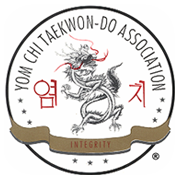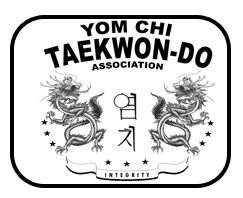WHAT YOMCHI MEANS
Although YOM CHI is the name for a national TaeKwon-Do association, in Korean the word means Integrity.
The single dragon patch, representing the student, has the same meaning as the official Logo of the YOM CHI TAEKWON-DO ASSOCIATION®.
Many students mistake Courtesy (Ye Ui) for Integrity (Yom Chi).
Although YOM CHI is the name for a national TaeKwon-Do association, in Korean the word means Integrity. The single dragon patch representing the student has the same meaning as the official Logo of the YOM CHI TAEKWON-DO ASSOCIATION®. Many students mistake Courtesy (Ye Ui) for Integrity (Yom Chi).


The two dragons facing each other represent the Taekwon-Do student and their instructor. The two symbols between the dragons are the han-gul (Korean alphabet) characters representing "Integrity." The nine stars arranged in three groups of three, represent the three levels of black belt: novice, expert, and master. The total of nine stars symbolizes the nine degrees of black belt.
This seal represents the word Integrity, which in Mandrin Chinese is pronounced lian-chi. In Korean, it is pronounced as YOM-CHI as shown in the double dragon logo above
Small seal Chinese script which was developed in the time of the birth of Christ in order to simplify recording by scribes and for the use in making official state seals for documents. For purposes of daily use, it was replaced by several other forms of script over the years, and is only used today by some calligraphers and in the making of seals (chops).

EXPLANATION OF TENETS AS BY GENERAL CHOI
INTEGRITY (YomChi) In Taekwon-Do, the word integrity assumes a looser definition than the one usually presented in Webster's dictionary. One must be able to define right and wrong and have the conscience, if wrong, to feel guilt. Listed are some examples, where integrity is lacking:
- The instructor who misrepresents himself and his art by presenting improper techniques to his students because of a lack of knowledge or apathy.
- The student who misrepresents himself by "fixing" breaking materials before demonstrations.
- The instructor who camouflages bad techniques with luxurious training halls and false flattery to his students.
- The student who requests rank from an instructor, or attempts to purchase it.
- The student who gains rank for ego purposes or the feeling of power.
- The instructor who teaches and promotes his art for materialistic gains.
- The student whose actions do not live up to his words.
- The student who feels ashamed to seek opinions from his juniors.
SHORT HISTORY OF CHARACTERS
The first Chinese characters began as primitive pictographs of natural objects, including many sorts of birds and beasts, in addition to the human body, dwellings, and utensils. These often took the form of turtle shell carvings used by the Kings of the Shang Dynasty between 1400 and 200 B.C. when consulting their ancestors or various gods about military matters. These characters were pictorial, having a close resemblance to their meaning. The large, soft shell of a freshly killed turtle was inscribed at the inner surface with appropriate characters and then heated over a fire until it cracked. Soothsayers interpreted answers by reading the pattern of cracks created among the previously incised characters. These first interesting marks are actually the prototype of characters and they may also be seen on the remains of animal bones - often known as Bone Script. At the beginning of the third century B.C., there were seven independent warring states. Emperor Shi Huangdi of Qin (221 - 206 B.C.) was successful in conquering the other six and unifying China. With this unification, he was also able to organize and consolidate the writing of Chinese characters into what is known as Seal Script. This script was well balanced and followed a rigid set of rules. It gave an impression of stability and grandeur, suggesting the solemn dignity of the Qin dynasty. Today Seal Script is regarded as the progenitor of all Chinese characters. Its chief use is on ornamental seals and seals impressed on works of art. Specific characteristics of this script are; an almost uniform, well balanced thickness in the strokes and composition, a general height-to-width ratio of three-to-two, and a general feeling that is grave and expressionless. These characters are written in an imaginary square having uniform and overall rectangular shape.
During the Tang Dynasty (A.D. 618 - 907), Block Script was developed as a new uniform, ordered, and graceful style which was an abbreviated form of both the Seal Script and a similar form known as Clerical Script. Unlike the later Cursive and Semi-Cursive Scripts which followed, it conformed to a rigid set of rules that as the formal style from the Eastern Jin Dynasty (317 - 420) to the present day.
